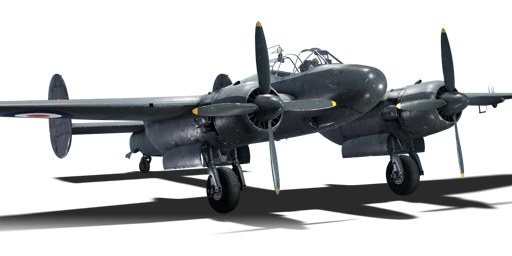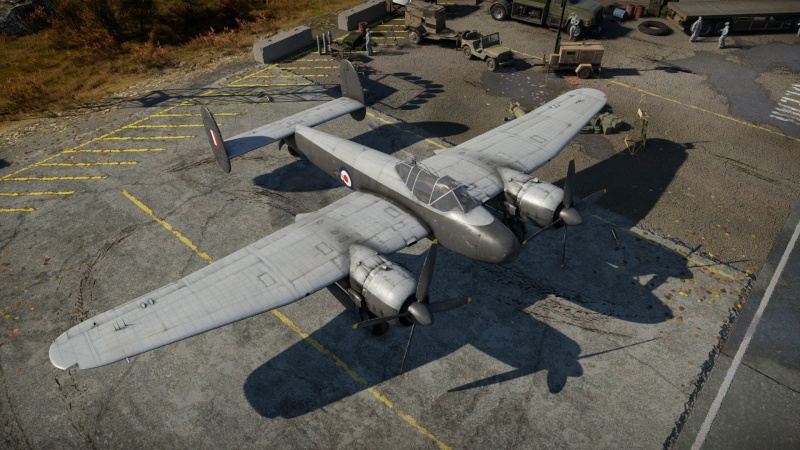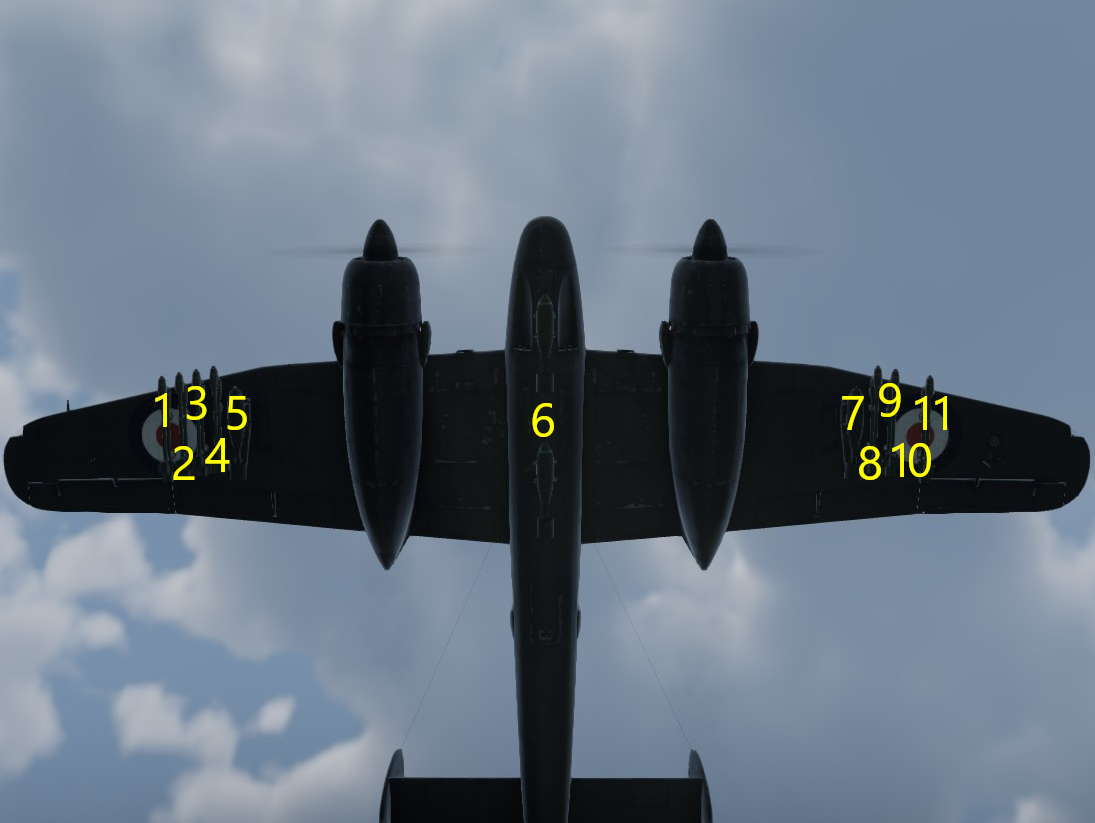Difference between revisions of "Brigand B 1"
Inceptor57 (talk | contribs) (→Description: Updated to new format) |
(→Suspended armament) |
||
| (One intermediate revision by the same user not shown) | |||
| Line 6: | Line 6: | ||
== Description == | == Description == | ||
<!-- ''In the description, the first part should be about the history of and the creation and combat usage of the aircraft, as well as its key features. In the second part, tell the reader about the aircraft in the game. Insert a screenshot of the vehicle, so that if the novice player does not remember the vehicle by name, he will immediately understand what kind of vehicle the article is talking about.'' --> | <!-- ''In the description, the first part should be about the history of and the creation and combat usage of the aircraft, as well as its key features. In the second part, tell the reader about the aircraft in the game. Insert a screenshot of the vehicle, so that if the novice player does not remember the vehicle by name, he will immediately understand what kind of vehicle the article is talking about.'' --> | ||
| − | Development for the Brigand began as a successor to the Beaufighter, namely as a strike aircraft and torpedo bomber. Bristol used their existing Buckingham aircraft design as the basis, but development delays caused the plane to not be ready until after the war in 1946. Without a war to fight, the Brigand was utilized for training or lower-intensity conflicts such as the communist insurgency in Malaya. | + | Development for the Brigand began as a successor to the Beaufighter, namely as a strike aircraft and torpedo bomber. Bristol used their existing Buckingham aircraft design as the basis, but development delays caused the plane to not be ready until after the war in 1946. Without a war to fight, the Brigand was utilized for training or lower-intensity conflicts such as the communist insurgency in Malaya. |
| − | Introduced in [[Update 1.63 "Desert Hunters"]], the Brigand B 1 can utilize its engine performance and armament for high-altitude interceptions against enemy bombers. With four nose-mounted 20 mm cannons, it can engage bombers head-on very easily. However, the Brigand's less impressive agility and roll speed means it is not very useful against | + | Introduced in [[Update 1.63 "Desert Hunters"]], the Brigand B 1 can utilize its engine performance and armament for high-altitude interceptions against enemy bombers. With four nose-mounted 20 mm cannons, it can engage bombers head-on very easily. However, the Brigand's less impressive agility and roll speed means it is not very useful against manoeuvrable targets, so it is only limited to large lumbering planes. If all bombers were shot down, the Brigand can move on to ground attack with its rockets and bombs and help the team whittle down the tickets needed for a victory. |
== General info == | == General info == | ||
| Line 146: | Line 146: | ||
{{Specs-Avia-Suspended}} | {{Specs-Avia-Suspended}} | ||
<!-- ''Describe the aircraft's suspended armament: additional cannons under the wings, bombs, rockets and torpedoes. This section is especially important for bombers and attackers. If there is no suspended weaponry remove this subsection.'' --> | <!-- ''Describe the aircraft's suspended armament: additional cannons under the wings, bombs, rockets and torpedoes. This section is especially important for bombers and attackers. If there is no suspended weaponry remove this subsection.'' --> | ||
| − | |||
| − | The '''''{{PAGENAME}}''''' can be outfitted with the following ordnance | + | The '''''{{PAGENAME}}''''' can be outfitted with the following ordnance: |
| − | |||
| − | |||
| − | |||
| − | |||
| − | |||
| − | |||
| − | |||
{| class="wikitable" style="text-align:center" width="100%" | {| class="wikitable" style="text-align:center" width="100%" | ||
|- | |- | ||
| Line 162: | Line 154: | ||
| rowspan="5" width="25%" | <div class="ttx-image">[[File:Hardpoints_{{PAGENAME}}.png]]</div> | | rowspan="5" width="25%" | <div class="ttx-image">[[File:Hardpoints_{{PAGENAME}}.png]]</div> | ||
|- | |- | ||
| − | ! 500 lb G.P. Mk.IV bombs | + | ! [[G.P. Mk.IV (500 lb)|500 lb G.P. Mk.IV]] bombs |
| || || || || 1 || 2 || 1 || || || || | | || || || || 1 || 2 || 1 || || || || | ||
|- | |- | ||
| − | ! 1,000 lb G.P. Mk.I bombs | + | ! [[G.P. Mk.I (1,000 lb)|1,000 lb G.P. Mk.I]] bombs |
| || || || || || 2 || || || || || | | || || || || || 2 || || || || || | ||
|- | |- | ||
| − | ! RP-3 rockets | + | ! [[RP-3]] rockets |
| 2 || 2 || 2 || 2 || || || || 2 || 2 || 2 || 2 | | 2 || 2 || 2 || 2 || || || || 2 || 2 || 2 || 2 | ||
|- | |- | ||
| Line 174: | Line 166: | ||
|- | |- | ||
|} | |} | ||
| + | |||
| + | {{Navigation-Start|Default weapon presets}} | ||
| + | {{Navigation-First-Simple-Line}} | ||
| + | * Without load | ||
| + | * 16 x RP-3 rockets | ||
| + | * 2 x 500 lb G.P. Mk.IV bombs (1,000 lb total) | ||
| + | * 4 x 500 lb G.P. Mk.IV bombs (2,000 lb total) | ||
| + | * 2 x 1,000 lb G.P. Mk.I bombs (2,000 lb total) | ||
| + | {{Navigation-End}} | ||
== Usage in battles == | == Usage in battles == | ||
Latest revision as of 11:11, 3 February 2024
Contents
Description
Development for the Brigand began as a successor to the Beaufighter, namely as a strike aircraft and torpedo bomber. Bristol used their existing Buckingham aircraft design as the basis, but development delays caused the plane to not be ready until after the war in 1946. Without a war to fight, the Brigand was utilized for training or lower-intensity conflicts such as the communist insurgency in Malaya.
Introduced in Update 1.63 "Desert Hunters", the Brigand B 1 can utilize its engine performance and armament for high-altitude interceptions against enemy bombers. With four nose-mounted 20 mm cannons, it can engage bombers head-on very easily. However, the Brigand's less impressive agility and roll speed means it is not very useful against manoeuvrable targets, so it is only limited to large lumbering planes. If all bombers were shot down, the Brigand can move on to ground attack with its rockets and bombs and help the team whittle down the tickets needed for a victory.
General info
Flight performance
| Characteristics | Max Speed (km/h at 4,267 m) |
Max altitude (metres) |
Turn time (seconds) |
Rate of climb (metres/second) |
Take-off run (metres) | |||
|---|---|---|---|---|---|---|---|---|
| AB | RB | AB | RB | AB | RB | |||
| Stock | 552 | 540 | 10300 | 27.2 | 28.0 | 11.0 | 11.0 | 600 |
| Upgraded | 613 | 580 | 24.9 | 26.0 | 19.8 | 14.7 | ||
Details
| Features | ||||
|---|---|---|---|---|
| Combat flaps | Take-off flaps | Landing flaps | Air brakes | Arrestor gear |
| ✓ | ✓ | ✓ | ✓ | X |
| Limits | ||||||
|---|---|---|---|---|---|---|
| Wings (km/h) | Gear (km/h) | Flaps (km/h) | Max Static G | |||
| Combat | Take-off | Landing | + | - | ||
| 680 | 342 | 430 | 404 | 270 | ~8 | ~3 |
| Optimal velocities (km/h) | |||
|---|---|---|---|
| Ailerons | Rudder | Elevators | Radiator |
| < 360 | < 390 | < 390 | > 327 |
Engine performance
| Engine | |||||
|---|---|---|---|---|---|
| Engine Name | Number present | ||||
| Bristol Centaurus 57 18-cylinder | 2 | ||||
| Engine characteristics | |||||
| Weight (each) | Type | Cooling | |||
| 1,220 kg | Radial | Air | |||
| Engine power (Stock) | |||||
| Mode | Max | Take-off | |||
| Arcade | 1,853 hp | 2,273 hp | |||
| Realistic/Simulator | 1,830 hp | 2,250 hp | |||
| Engine power (Upgraded) | |||||
| Mode | Max | Take-off | |||
| Arcade | 2,428 hp | 2,848 hp | |||
| Realistic/Simulator | 2,100 hp | 2,520 hp | |||
| WEP Duration | |||
|---|---|---|---|
| Arcade | Realistic/Simulator | ||
| 25 seconds | Infinite | ||
Survivability and armour
- 64 mm Bulletproof glass in cockpit front.
- 12.7 mm Steel plate in pilot's seat.
- 12.7 mm Steel plate in the nose.
- 12.7 mm Steel plate in the fuselage.
Modifications and economy
Armaments
Offensive armament
The Brigand B 1 is armed with:
- 4 x 20 mm Hispano Mk.V cannons, nose-mounted (200 rpg = 800 total)
Suspended armament
The Brigand B 1 can be outfitted with the following ordnance:
| 1 | 2 | 3 | 4 | 5 | 6 | 7 | 8 | 9 | 10 | 11 | ||
|---|---|---|---|---|---|---|---|---|---|---|---|---|
| 500 lb G.P. Mk.IV bombs | 1 | 2 | 1 | |||||||||
| 1,000 lb G.P. Mk.I bombs | 2 | |||||||||||
| RP-3 rockets | 2 | 2 | 2 | 2 | 2 | 2 | 2 | 2 | ||||
| Maximum permissible loadout weight: 1,690 kg Maximum permissible weight imbalance: 500 kg | ||||||||||||
| Default weapon presets | |
|---|---|
| |
Usage in battles
In AB and RB, you should immediately bomber hunt, as those will be your easiest kills, combined with your bomber altitude, you should stay high until you run out of targets to engage then you should go for fighters, before ground targets when it is safe to do so. When diving, use your airbrakes to be sure not to exceed your maximum speed of 680kph in a dive. Exceeding 550kph, sustaining a flick roll and other sharp acrobatics may break your wings.
How to offensively engage an enemy aircraft:
While it is tempting because of the Brigand's strong armament, avoid fully committing to head ons where possible, as the Brigand has a sluggish control response which will impede your ability to dodge and you will almost certainly receive some damage if you do not break off quickly after firing. When engaging bomber targets, avoid sitting on their tail as the Brigand is a large target for their tail gunners - make a high speed pass, disengage, and assess the enemy bomber for another attack if necessary. Be wary dogfighting fighters, as while the Brigand is quite capable at turning, its ability to retain and generate energy is below most fighters, and firing solutions can be difficult to capitalise on due to its unwieldy controls. In a long fight or at a numerical disadvantage this can easily become your downfall.
How to perform defensive fighting:
Should an enemy get on your six, your best bet is to bolt towards allied fighters/airfield and give the enemy a hard time aiming at you. While moving in the same general direction, dart your nose around and play with the roll and rudder. Flick rolls are a near-necessity in the Brigand to quickly rotate the aircraft and will be a crucial asset to dodge guns. Avoid going up when defensive, as you will quickly find yourself low on energy and vulnerable. The Brigand is a large target, so you must maintain situational awareness to be able to dodge incoming shots, else you will almost certainly be hit.
Manual Engine Control
| MEC elements | ||||||
|---|---|---|---|---|---|---|
| Mixer | Pitch | Radiator | Supercharger | Turbocharger | ||
| Oil | Water | Type | ||||
| Not controllable | Controllable Not auto controlled |
Controllable Auto control available |
Controllable Auto control available |
Separate | Controllable 2 gears |
Not controllable |
Pros and cons
Pros:
- Great armament of four nose-mounted Hispano V cannons
- Bomber spawn (AB and RB)
- Decently manoeuvrable for an aircraft of its size, especially with combat flaps, capable of out-turning fighters like the Bf 109 and P-51 at some speeds
- Plenty of ammo
- Good attack payloads of 2,000 lbs or 16 RP-3 Rockets, even mixed
- Very good cockpit visibility
- Heavy armour on the nose of aircraft for head-ons
- Air brakes that provide lift upon usage
Cons:
- Generally slow
- Average climb rate
- Massive target
- No defensive gunners on the aircraft
- Air brakes lack performance under 600 km/h
- Early bomb modifications are mounted far on the wings, making them hard to aim
- Bad roll rate
- Poor performance at high altitude
History
Designed to replace the famous Bristol Beaufighter series, the Bristol Type 164 "Brigand" was based on the already in production Bristol Buckingham, a transport/liaison aircraft intended to have been a medium bomber like the Wellington. Because of this, the Brigand was substantially larger than its predecessor and its performance suffered in suit. Originally conceived as a fast torpedo attacker, the Brigand turned out to be a heavy strike bomber, and only the first eleven airframes were ever torpedo capable.
The Brigand B.1 as seen in-game would first see service with No. 84 and No. 8 Sqn RAF in Aden, modern-day Yemen. While not seeing action, the hot, dry climate of the Arabian peninsula was ideal for the Brigand and production continued. The Brigand would next be handed over to Beaufighter squadron No. 45 based out of Tengah, Singapore in engaging Communist guerillas in and around Malaya (Modern day Malaysia). It was here where the Brigand would receive its trial of fire, bombing and rocketing swathes of the South-East Asian jungles on the hunt for this red menace. However, the humid climate and constant stress from dive bombing would be the death sentence for this aircraft. The leather and rubber seals used on the hydraulic jacks of the landing gear and dive brakes rotted away, causing gear failures and some dive brakes failing, leading to crashes and wing tearing. This, combined with the Brigand's wings being unable to cope with the constant dive-bombing, led to it being withdrawn from service in Malaya by 1952, and from Aden by 1954.
Media
- Skins
- Videos
See also
Links to the articles on the War Thunder Wiki that you think will be useful for the reader, for example:
- reference to the series of the aircraft;
- links to approximate analogues of other nations and research trees.
External links
| Bristol Aeroplane Company | |
|---|---|
| Strike Aircraft | Beaufighter Mk I (40-mm) · Beaufighter Mk VIc · Beaufighter Mk X · Beaufighter Mk 21* |
| Bombers | Blenheim Mk IV · Beaufort Mk VIII* · Brigand B 1 |
| * License-produced in Australia by Department of Aircraft Production. | |
| Britain bombers | |
|---|---|
| Torpedo | Swordfish Mk I · Swordfish Mk II · ▄Avenger Mk II |
| Dive | V-156-B1 |
| Hydroplanes | ▄Catalina Mk IIIa · Sunderland Mk IIIa · Sunderland Mk V |
| Light | Blenheim Mk IV · Beaufort Mk VIII · ▄Hudson Mk V · Brigand B 1 |
| Based on A20 | ▄Havoc Mk I · ▄Boston Mk I · ▄DB-7 |
| Hampden | Hampden Mk I · Hampden TB Mk I |
| Wellington | Wellington Mk Ic · Wellington Mk Ic/L · Wellington Mk III · Wellington Mk X |
| Halifax | Halifax B Mk IIIa |
| Stirling | Stirling B Mk I · Stirling B Mk III |
| Lancaster | Lancaster B Mk I · Lancaster B Mk III |
| Lincoln | Lincoln B Mk II |
| Shackleton | Shackleton MR.Mk.2 |






